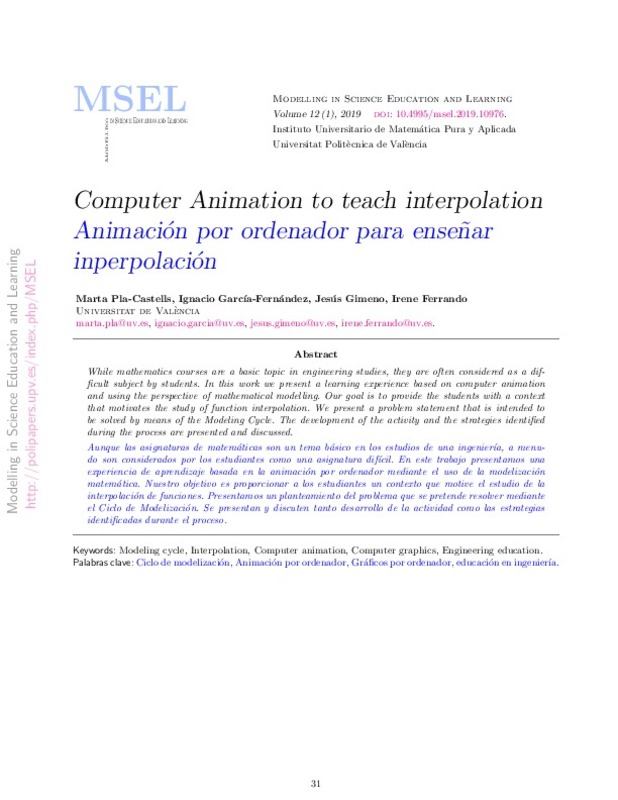Burkhard A Alpers, Marie Demlova, Carl-Henrik Fant, Tommy Gustafsson, DuncanLawson, Leslie Mustoe, Brita Olsen-Lehtonen, Carol L Robinson, and Daniela Velichova.A framework for mathematics curricula in engineering education: a report of the mathematics working group. Technical report, European Society for Engineering Education(SEFI), 2013.
Jonas Bergman ̈Arleb ̈ack. On the use of realistic fermi problems for introducing mathe-matical modelling in school.The Mathematics Enthusiast, 6(3):331-364, 2009.
Phillip Barry and Ronald Goldman. Recursive evaluation algorithm for a class of catmull-rom splines. In International Conference on Computer Graphics and Interactive Tech-niques, volume 22, pages 199-204, 08 1988.
[+]
Burkhard A Alpers, Marie Demlova, Carl-Henrik Fant, Tommy Gustafsson, DuncanLawson, Leslie Mustoe, Brita Olsen-Lehtonen, Carol L Robinson, and Daniela Velichova.A framework for mathematics curricula in engineering education: a report of the mathematics working group. Technical report, European Society for Engineering Education(SEFI), 2013.
Jonas Bergman ̈Arleb ̈ack. On the use of realistic fermi problems for introducing mathe-matical modelling in school.The Mathematics Enthusiast, 6(3):331-364, 2009.
Phillip Barry and Ronald Goldman. Recursive evaluation algorithm for a class of catmull-rom splines. In International Conference on Computer Graphics and Interactive Tech-niques, volume 22, pages 199-204, 08 1988.
Blender Online Community.Blender - a 3D modelling and rendering package. BlenderFoundation, Blender Institute, Amsterdam, 2018.
Werner Blum and Dominik Leiß. How do students and teachers deal with modellingproblems? InMathematical Modelling: Education, Engineering and Economics-ICTMA12, pages 222-231. Elsevier, 2007.
Rita Borromeo-Ferri.Learning How to Teach Mathematical Modeling in School andTeacher Education. Springer, 2017.
Richard L Burden and J Douglas Faires.Numerical analysis. Cengage Learning, 2010.
Edwin Catmull and Raphael Rom. A class of local interpolating splines. InComputeraided geometric design, pages 317-326. Elsevier, 1974.
Heidi A Diefes-Dux, Tamara Moore, Judith Zawojewski, PK Imbrie, and Deborah Foll-man. A framework for posing open-ended engineering problems: Model-eliciting activi-ties. In34th Frontiers in Education, 2004.
Karl Frey. Integrated science education: 20 years on.International Journal of ScienceEducation, 11(1):3-17, 1989.
Daniel Gil, Jaime Carrascosa, Carlos Furi ́o, and Joaqu ́ın Mart ́ınez-Torregrosa.Laense ̃nanza de las ciencias en la educaci ́on secundaria. Institut de Ci'encies de l'Educaci ́o.Universidad de Barcelona, 1991.
Eric Hamilton, Richard Lesh, FRANK Lester, and Michael Brilleslyper. Model-elicitingactivities (MEAs) as a bridge between engineering education research and mathematicseducation research.Advances in Engineering Education, 1(2):n2, 2008.
Gabriele Kaiser and Susanne Brand. Modelling competencies: Past development andfurther perspectives. InMathematical modelling in education research and practice, pages129-149. Springer, 2015.
Isaac Kerlow.The art of 3D: computer animation and effects. Wiley Publishing, 2009.
Eric Lengyel.Mathematics for 3D game programming and computer graphics. CengageLearning, 2012.
Richard Lesh and Helen Doerr, editors.Foundations of a model and modeling perspectiveon mathematics teaching, learning, and problem solving. Lawrence Erlbaum Associates,2003.
José María Núñez Espallargas and Vicenç Font Moll. Aspectos ideológicos en la con-textualización de las matemáticas: una aproximaci ́on hist ́orica.Revista de educaci ́on,306:293-314, 1995.
E.A. Sánchez-Pérez, LM García Raffi, and JV Sánchez Pérez. Introducción de las técnicas de modelización para el estudio de la física y de las matemáticas en los primeros cursos delas carreras técnicas. Enseñanza de las ciencias: revista de investigación y experiencias didácticas, 17(1):119-129, 1999.
[-]








